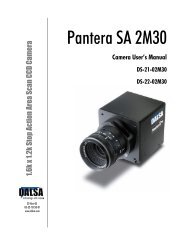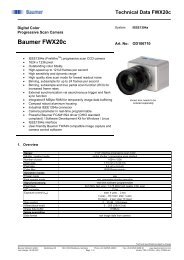TR-33 TR-34 TR-35 Trillium Rhino User's Manual - Frame Grabbers
TR-33 TR-34 TR-35 Trillium Rhino User's Manual - Frame Grabbers
TR-33 TR-34 TR-35 Trillium Rhino User's Manual - Frame Grabbers
Create successful ePaper yourself
Turn your PDF publications into a flip-book with our unique Google optimized e-Paper software.
<strong>Trillium</strong> User’s <strong>Manual</strong> 43<br />
Illumination<br />
The amount and wavelengths of light required to capture useful images depend<br />
on the particular application. Factors include the nature, speed, and spectral<br />
characteristics of objects being imaged, exposure times, light source<br />
characteristics, environmental and acquisition system specifics, and more.<br />
It is often more important to consider exposure than illumination. The total<br />
amount of energy (which is related to the total number of photons reaching the<br />
sensor) is more important than the rate at which it arrives. For example, 5µJ/cm 2<br />
can be achieved by exposing 5mW/cm 2 for 1ms just the same as exposing an<br />
intensity of 5W/cm 2 for 1µs.<br />
Light Sources<br />
Keep these guidelines in mind when setting up your light source.<br />
• Halogen light sources generally provide very little blue relative to IR.<br />
• Fiber-optic light distribution systems generally transmit very little blue<br />
relative to IR.<br />
• Some light sources age; over their lifespan they produce less light. This aging<br />
may not be uniform—a light source may produce progressively less light in<br />
some areas of the spectrum but not others. The camera's calibration process<br />
can compensate for this degradation, assuming there is still sufficient blue<br />
light.<br />
Filters<br />
4.3 EMC Operation<br />
CCD cameras can be extremely responsive to infrared (IR) wavelengths of light.<br />
To prevent infrared from distorting the images you scan, the camera uses a “hot<br />
mirror” or IR cutoff filter that transmits visible wavelengths but does not<br />
transmit wavelengths over 700µm. Depending on your application, additional<br />
filters may be justified.<br />
The <strong>Trillium</strong> has been designed for EMC compliance, including the supplied<br />
cables.<br />
Follow these specific guidelines to maximize compliance in your application:<br />
• Keep all cables as short as possible.<br />
• All cables must have 95% coverage shields that include braided wire. Metallic<br />
foil shields are insufficient without braided wire.<br />
DALSA 03-32-10119-03
















